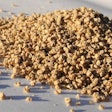Poultry farming and chicken consumption in China are expected to grow over the coming years, even if the high price of chicken feed and a tightening labor market are making the operating environment for chicken farms more difficult.
China is the world’s second largest poultry producer. With 17 million metric tons of chicken meat produced annually, the country accounts for 18 percent of global production.
Over the last 15 years, poultry meat consumption in China has grown by 3.9 percent per annum, outpacing the growth in consumption of beef, mutton and pork, the latter being the Chinese meat of choice. This faster pace of growth is expected to continue, in part because of the ease of rearing poultry for producers, and also because of its ease of preparation in the home, reveals the Rabobank report, "Can China's Poultry Move Out of Pork's Shadow?"
Poultry types
China’s poultry market comprises broilers, spent hens and waterfowl; three types enjoy market shares of 50, 20 and 30 percent, respectively.
Within the broiler sector, there is the further distinction: birds derived from local breeds, known as yellow-feathered, and from imported breeds, known as white-feathered. The market share of birds derived from imported genetics – now standing at some 51 percent – has been increasing, and this trend is expected to continue.
Changing poultry consumption patterns
Demand for poultry in China varies from region to region. In the North, there is less preference for bird type than in the South, and white-feathered birds have come to dominate that market. In the South, yellow-feathered birds remain the preference. However, demand for white-feathered birds is growing, particularly from factory canteens and schools. Rabobank believes that, even in the South, the preference for yellow-feathered birds will decline and that they could become a niche premium product rather than one of mass consumption.
Poultry is seen as healthier than pork, beef or mutton, although it is not free from food safety concerns, yet it is not the nation’s favorite source of animal protein. That title belongs to pork, and chicken meat is often viewed as a pork substitute.
Pork production has been successful in China. It is close to saturation point among middle- and high-income groups suggesting that, for pork, the only growth avenues remaining on the home market are lower income groups and processed products.
Poultry and poultry products have yet to reach the same level of penetration, meaning there is still room to grow the market. An additional factor in poultry’s predicted growth is its better acceptance among the younger generation, and so it is expected to gradually take market share from pork.
Reaching the chicken consumer
Poultry meat is required by the retail market, foodservice, institutional buyers and by further-processing companies. It is demand from quick-service restaurants, however, that has been the driving force behind the growth in the country’s poultry industry.
Quick-service restaurants have grown rapidly in China. The two main quick-service restaurant chains in China, KFC and McDonald's, have increased their outlet numbers to 4,000 and 1,500, respectively, as of December 2011. Poultry is the main item on the menu in both Western- and local-style quick-service restaurants. Quick-service restaurants have particularly driven demand for white-feathered birds, however the extent to which they will further drive demand is questionable. The country’s economic slowdown in 2012 had impacted the growth of quick-service restaurants and their influence may have already peaked.
The next major influence on poultry production is expected to be the retail market for frozen and further-processed food. Currently, the selection of poultry products in supermarkets and wet markets is limited, and unpackaged or unbranded goods dominate. To date, frozen poultry products have not been greatly accepted.
Market difficulties
Production prices in China remain above the levels of previous years. For most of 2012, profitability was negative. The main drivers of these costs were higher poultry feed costs and rising labor costs. The cost of labor has risen by an annual average of in excess of 10 percent over the last five years, and producers have been unable to pass this on to consumers.
Disease is also acting as a brake on development. Looking back to 2003, SARS and H1N5 saw consumers turn away from poultry meat. Since then, avian influenza and other diseases have had repeated negative impacts on the industry, and mortality rates have been as high as 10 percent on some large-scale farms. Properly implemented disease prevention and control measures will be essential to further development of the sector.
China’s trade with the outside world in poultry products has been negative over recent years, both by value and by volume, yet volume imports are declining. Nevertheless, China is now an important destination for products considered "by-products" in many other markets. The Chinese market is complementary to the rest of the world in terms of by-products, and the country’s imports of these is expected to continue to grow.
Exports have been relatively stable over recent years, and 74 percent of the total goes to Hong Kong. Yet, as with the home market, China’s poultry exports are becoming less competitive due to rising input costs. In addition, a strengthening currency also makes exports less attractive.
Poultry production methods
Within poultry production, vertical integration is growing faster than other production methods, largely because it has proven effective in assuring food safety, but also because it raises efficiency through productivity and employment of technology. There is often regional support available to establish this model as it is seen as modernization. However, this model is not expected to become dominant because of the requirement for land, capital and management knowledge.
The leading model in Chinese poultry production is contract farming with the typical contact farmer producing some 30,000 birds annually. There is still room within this model to increase output with some farms having the potential to triple output.







